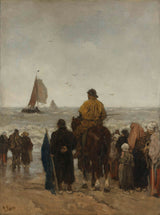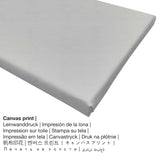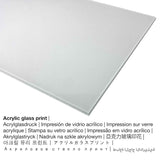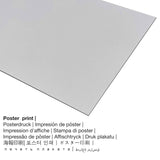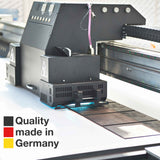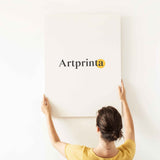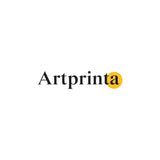Jacob Maris, 1884 - Ọbịbịa nke ụgbọ mmiri - ọmarịcha nka
Ụtụ gụnyere. Mbupu gbakọrọ na ndenye ọpụpụ.
Nhọrọ akụrụngwa enwere ike
Maka mbipụta nka ọ bụla anyị na-enye ụdị nha na ihe dị iche iche. Ị nwere ike ịhọrọ n'ime nhọrọ nhazi ngwaahịa ndị a:
- Akwụkwọ mmado na ihe kwaaji: A poster print is a UV printed canvas paper with a granular surface finish. Please bear in mind, that depending on the size of the poster print we add a white margin between 2-6 cm around the print motif to facilitate the framing with a custom frame.
- Mbipụta iko acrylic (nke nwere ezigbo mkpuchi iko): The print on acrylic glass, which is often labelled as a fine art print on plexiglass, will turn the original artwork into lovely décor. Additionally, it offers a good alternative to canvas or aluminium dibond fine art replicas. The work of art is being manufactured with the help of modern UV direct print technology. It makes vivid, impressive color hues. With an acrylic glass fine art print contrasts and also granular painting details will be more exposed because of the granular gradation. The plexiglass protects your custom art print against light and external influences for many years to come.
- Mbipụta nke aluminom: Aluminium Dibond prints are prints on metal with an impressive effect of depth - for a modern look and a non-reflective surface. For the Direct Aluminium Dibond print, we print your artpiece onto the surface of the white-primed aluminum. The colors of the print are luminous and vivid in the highest definition, the fine details appear very clear, and the print has a a matte appearance you can literally feel.
- Kwaaji: The canvas direct print is a printed cotton canvas stretched on a wood stretcher. What is more, canvas print creates a nice and appealing ambience. Canvas Prints have the advantage of being low in weight, which implies that it is easy to hang up your Canvas print without extra wall-mounts. A canvas print is suited for any type of wall.
Disclaimer: We try our best in order to describe our products as exact as possible and to display them visually. At the same time, some tone of the printed materials, as well as the print result can differ somehwat from the representation on your screen. Depending on the settings of your screen and the nature of the surface, color pigments may not be printed 100% realistically. Because all our art reproductions are processed and printed manually, there may as well be slight discrepancies in the size and exact position of the motif.
Ozi nka si Rijksmuseum website (© nwebiisinka - Rijksmuseum - Rijksmuseum)
Waiting for the catch was a daily event on the beach at Scheveningen. Everyone in the village, young and old, came out to pilot the boats to shore, to haul them up onto the beach by horse, and to snap up the freshly caught fish. The format and composition that Maris chose for this painting draws us into the scene; we seem to be queueing up, as it were.
Mbipụta nka ọhụhụ nke onwe gị
In 1884 na nwoke onye na-ese ihe Jacob Maris made this piece of art. Nowadays, this artpiece belongs to the Rijksmuseum's nchịkọta ihe osise dijitalụ, nke bụ ihe ngosi nka kacha ukwuu maka nka na akụkọ Dutch site na Middle Ages ruo ugbu a. Site n'ikike nke: Rijksmuseum (ikikere - ngalaba ọha) .Ebe E Si Nweta nke ọrụ nka: . E wezụga nke ahụ, nhazi ahụ dị n'ime Eserese format ma nwee oke nke 3: 4, nke pụtara na ogologo bụ 25% mkpụmkpụ karịa obosara.
Ozi ndabere gbasara nka nka izizi
| Akụkụ nka: | "Arrival of the Boats" |
| Nhazi nke ọrụ nka: | sere |
| Otu izugbe: | nkà nke oge a |
| Century: | 19th narị afọ |
| Emepụtara na: | 1884 |
| Afọ nka: | ihe karịrị 130 afọ |
| Egosiputara na: | Rijksmuseum |
| Ebe ngosi nka: | Amsterdam, Netherlands |
| URL nke ihe ngosi nka: | Rijksmuseum |
| Ụdị nka nka: | ngalaba ọha |
| Site n'aka: | Rijksmuseum |
Nkọwa ihe ahaziri ahazi
| Nkewa ngwaahịa: | ezi nka mmeputakwa |
| Mmeputakwa: | dijitalụ mmeputakwa |
| Usoro nhazi: | UV kpọmkwem obibi |
| Ihe ngosi: | emepụtara na Germany |
| Stockdị ngwaahịa: | a na-achọ |
| Ihe eji eme atụmatụ: | foto mgbidi, ihe ndozi mgbidi |
| Ndozi onyonyo a: | nhazi ihe osise |
| Ụdị anya: | 3: 4 |
| Mmetụta akụkụ onyonyo: | ogologo bụ 25% mkpụmkpụ karịa obosara |
| Akwa ngwaahịa dị: | Mpempe akwụkwọ, akwụkwọ mmado (akwụkwọ akpa), mbipụta enyo acrylic (nwere ezigbo mkpuchi iko), mbipụta ọla (aluminium dibbond) |
| Mbipụta kanvas (akwa akwa na etiti ihe ndọtị): | 30x40cm - 12x16", 60x80cm - 24x31", 90x120cm - 35x47", 120x160cm - 47x63" |
| Acrylic glass print (nwere ezigbo mkpuchi iko) nhọrọ: | 30x40cm - 12x16", 60x80cm - 24x31", 90x120cm - 35x47", 120x160cm - 47x63" |
| Mpempe akwụkwọ mmado (akwụkwọ kwaaji) nha: | 30x40cm - 12x16", 60x80cm - 24x31", 90x120cm - 35x47" |
| Mpempe akwụkwọ Dibony (ihe alumnium) nha dị iche iche: | 30x40cm - 12x16", 60x80cm - 24x31", 90x120cm - 35x47" |
| Igwe onyonyo: | adịghị |
Banyere onye na-ese ihe
| Aha onye nka: | Jacob Maris |
| okike onye nka: | nwoke |
| Obodo onye nka: | Dutch |
| Ọrụ nke onye na-ese ihe: | onye na-ese ihe |
| Mba onye si: | mba netherland |
| Nkewa onye nka: | omenkà nke oge a |
| Nwụrụ anwụ: | 62 afọ |
| Amụrụ n'afọ: | 1837 |
| Afọ nwụrụ: | 1899 |
© Nwebiisinka nke | Artprinta (www.artprinta.com)

